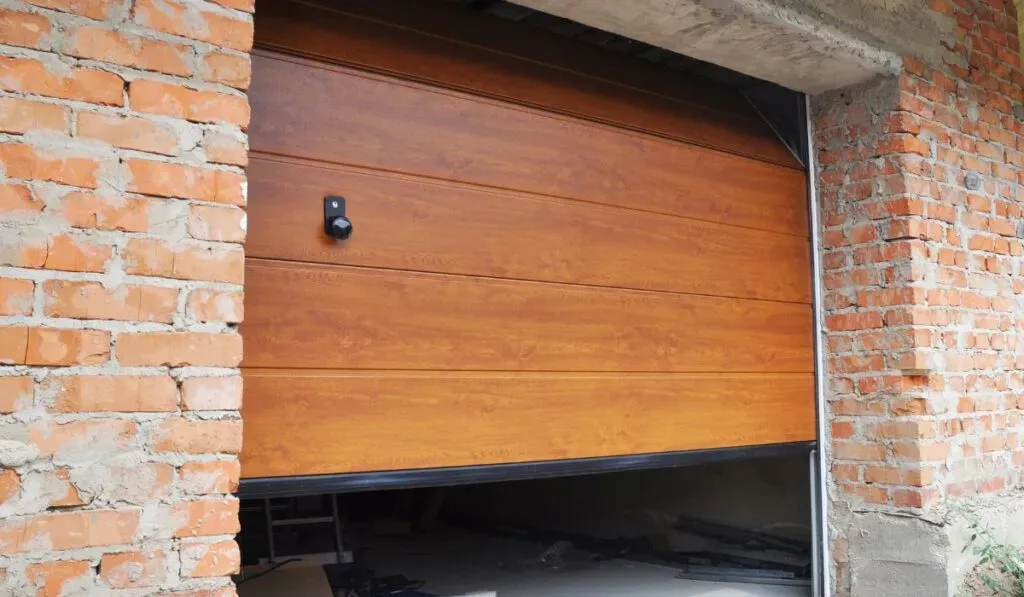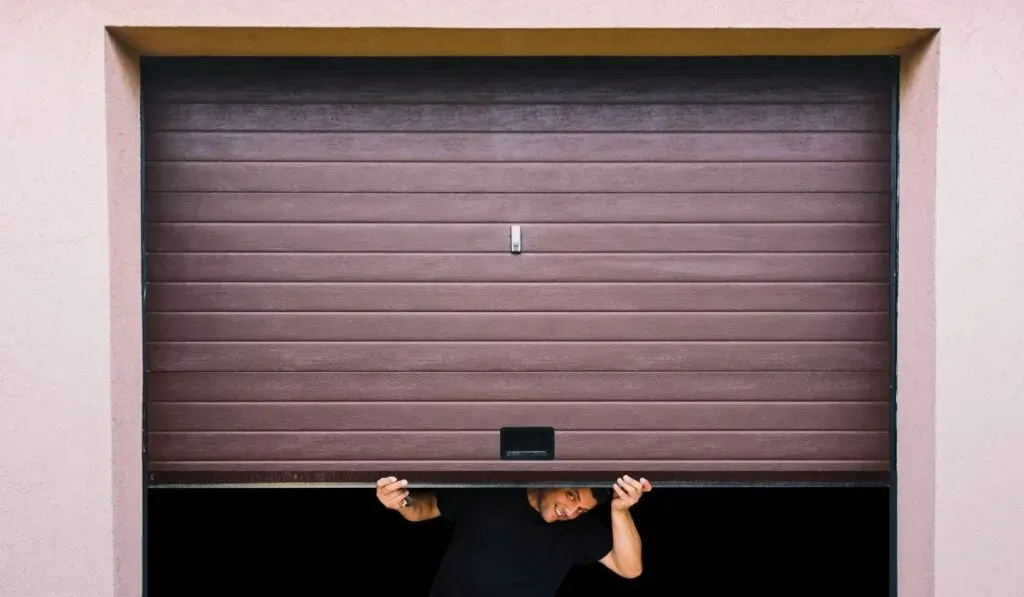
We focus on how to safely manage an off-track garage door, avoid risks, and understand common causes like broken springs or misaligned tracks.
We offer quick, expert help to fix your off-track garage door and guide you through the proper steps for a secure repair.
Is Your Garage Door Off Track? Spotting the Warning Signs
If you think your garage door might be off track, you should check for signs fast. A door that’s off track can be unsafe and cost a lot to fix later. Here are some things to look for if you suspect your garage door is misaligned.
Crooked or Tilted Door – A Visual Indicator
One easy way to tell if the door is off is by how it looks. If it seems crooked or tilts weirdly, something is wrong. Look out for:
- Garage door crooked appearance: The door shouldn’t lean to one side.
- Imbalanced garage door: Both sides should match up evenly.
- Garage door gaps: Spaces between the door edges and frame mean trouble.
Gaps Between Rollers and Track – Binding Issues
Sometimes the rollers don’t sit right in the track. This causes binding and makes the door hard to open or close. Watch for these signs:
- Garage door rollers: Check if they’re moving smoothly.
- Worn rollers: Old or damaged rollers cause rough movement.
- Garage door roller wear: Look for cracks or dents on rollers.
- Resistance in movement: If the door feels stuck or tight, something’s wrong.
Unusual Noises – Grinding or Scraping Sounds
Your ears can warn you too. Strange sounds often point to alignment problems. Listen for:
- Garage door grinding noises: Sounds like metal scraping means parts rub each other.
- Garage door noise causes: Could be loose parts hitting or scraping.
- Garage door screeching: Sharp squeaks suggest rollers aren’t rolling right.
- Door off track noise: Noise changes when the door moves out of place.
Loose or Tangled Cables – A Critical Warning Sign
Cables hold up a lot of weight and keep the door balanced; if you notice any fraying or damage, our expert garage door cable repair service can quickly resolve the issue. If cables get loose or frayed, things get risky fast. Check these carefully:
- Garage door cables: Should be tight and straight.
- Broken garage door cable: Frayed or snapped cables need fixing now.
- Garage door cable fraying: Worn cables might snap soon, causing danger.
Spotting these warning signs early helps you avoid bigger problems later. If you notice any of this stuff, don’t mess with it yourself—garage doors work with strong springs that can hurt you badly. Call a pro to fix things safely before damage gets worse!
Common Causes of an Off-Track Garage Door
Knowing why your garage door goes off track helps you fix it sooner. Here are the most common reasons this happens.
Impact Damage: Vehicle Collision or Accidental Hits
Garage door impact damage happens when a car hits the door or something crashes into it. This force can bend the tracks, break rollers, or hurt other parts. Even small bumps can cause misalignment that gets worse over time.
Damaged components from impact may include:
- Bent or warped tracks
- Broken rollers
- Cracked panels
- Loose hardware
If you see dents, cracks, or odd gaps after a hit, you need garage door collision repair. Ignoring damage risks bigger problems and safety issues.
Worn or Broken Rollers – How Aging Components Contribute
Garage door rollers help the door move smoothly on its tracks. Over time, worn rollers lose their shape because of friction and dirt.
Signs that rollers wear out:
- Noisy operation with grinding sounds
- Resistance when opening or closing
- Cracks or flat spots on rollers
Worn rollers put more stress on cables and springs. Getting a professional garage door roller replacement promptly stops more serious trouble and ensures your door operates smoothly.
Misaligned Tracks – The Root of Many Off-Track Problems

Garage door track misalignment is a main cause of off-track doors. Tracks can move because brackets get loose, impacts happen, or parts wear out slowly.
Signs of track misalignment include:
- Gaps between track and wall or frame
- Uneven movement with resistance
- Rollers popping out often
Even small misalignments matter (usually more than 1/8 inch). Proper alignment lets the door move smoothly without binding or jerking, especially when you schedule an expert garage door track repair to ensure precision.
Damaged Cables – Frayed or Snapped Cables
Garage door cables carry heavy loads when lifting your door. Over time, cables fray from metal fatigue, rust, or bad tension around cable drums.
Look for these cable problems:
- Frayed strands you can see
- Uneven tension making movement lopsided
- Snapped cables causing sudden failure
Broken garage door cable is dangerous because it controls balance under strong tension. Have a pro check cables before trying to repair them yourself.
Obstructions – Debris and Objects Blocking the Tracks
Sometimes junk blocks the tracks and makes doors come off track. Dirt, leaves, stones, toys, or tools near garage door tracks cause jams that push rails out of place.
Regular cleaning clears garage door track obstruction. This keeps all parts moving well without strain.
Call a Professional Immediately
Fixing an off-track garage door isn’t a simple DIY job. Springs have high tension and realigning parts is tricky. Call 24/7 Garage Door Repair for quick expert help that keeps you safe.
Learn more about our professional door-off-track-repair services | Fix noisy doors here.
Safety Actions – Power Off and Secure the Door
If your garage door goes off track, stop using it right away. First, power off the garage door opener by unplugging it or flipping the circuit breaker. This stops it from turning on by accident and making things worse.
You can disengage the garage door opener by pulling the emergency release cord—only if you really know what you’re doing. But be careful! An off-track door might fall suddenly since it’s not supported well.
Always keep clear of the door area. Keep kids and pets away, too. An off-track garage door is a big safety hazard. It can fall or shift without warning.
If you want to secure the door by placing blocks or something else under it, better let a pro handle that. Garage doors are heavy and tricky. Trying yourself can cause injury or more damage.
Remember these safety tips:
- Stop using both manual and automatic openers.
- Disconnect power to stop unexpected movement.
- Keep people far from the door area.
- Don’t touch springs, cables, or tracks.
- Call a professional for help right away.
Taking these steps helps keep everyone safe and prevents more damage until a pro arrives.
Visually Inspect the Garage Door System – Identify Damage
Once power is off and the area is clear, look at your garage door from a safe distance. Check for signs that show your door is off track or misaligned:
- Crooked appearance: The bottom edge doesn’t sit level on the floor.
- Gaps between tracks: Spaces where rollers should fit tightly in metal tracks.
- Rollers popped out: Rollers come loose from their guides on one side.
- Resistance when moving: The door feels stuck or hard to open or close.
- Unusual noises: Grinding or scraping sounds when you try to move it.
These signs mean you need a professional to fix it. Don’t try DIY fixes here—misaligned tracks often have more than 1/8 inch gap which causes problems.
If possible, take photos of what you see. This helps repair techs understand the problem before they come.
How to Fix a Garage Door Off Track – Professional Repair Steps for Realignment
If your garage door goes off track, it needs professional attention. Trying to fix it yourself, especially the re-rail part, can be risky. Garage doors have strong springs and cables under high tension. Skilled technicians follow careful steps to keep things safe and get the door working right.
Here’s how pros usually fix it:
- Thorough Inspection: They check the whole door system—tracks, rollers, cables, springs, and hardware—to find what’s wrong.
- Power Disconnection: Before starting, they unplug or switch off the opener for safety.
- Track Realignment: Using special tools, they adjust the tracks carefully to keep everything aligned.
- Roller Replacement or Adjustment: Damaged rollers get replaced; others are lubed and set right on the tracks.
- Cable and Spring Check: They look at cables for frays or breaks and test springs for balance.
- Door Re-Railing (If Needed): Putting rollers back on tracks needs care—forcing parts can cause injury. Pros handle this part best.
- Balance Testing & Final Adjustments: The door moves manually and with the opener to make sure it’s smooth.
- Safety System Verification: Sensors and auto-reverse features get tested last.
This step-by-step way helps your garage door work well again without causing more damage or hurting anyone.
